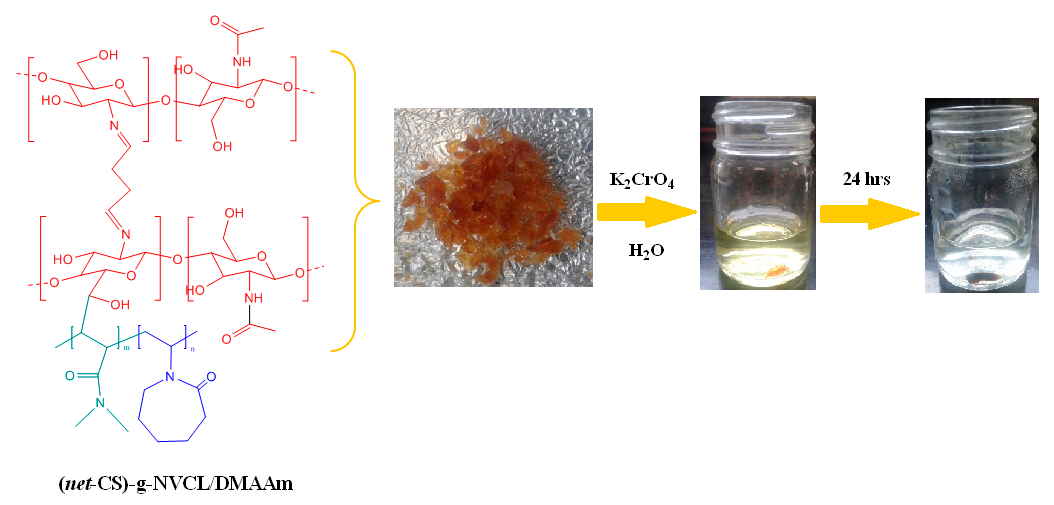Removal of Cr(VI) ions using a binary grafting of N-vinylcaprolactam and N,N -dimethylacrylamide onto crosslinked chitosan, synthesized by gamma radiation
DOI:
https://doi.org/10.29356/jmcs.v63i4.980Keywords:
Chitosan networks, Cr(IV) retention, adsorption isotherms, radiation grafting, N-vinylcaprolactactamAbstract
Chitosan is characterized by its good affinity of metal ions due to high amount of amino groups. However, crosslinking of chitosan results in a dramatic decrease of retention properties due to reaction of amino groups during process. N,N-dimethylacrylamide (DMAAm) increases the hidrophilicity of the system and improve the apparent mechanic properties; while N-vinylcaprolactam (NVCL), a temperature stimuli sensitive monomer with a LCST of about 32 oC, makes possible for reuse the material. Adsorption of Cr(VI) onto crosslinked chitosan (net-CS) and NVCL/DMAAm binary grafted system onto net-CS, synthesized by gamma radiation of 60Co, has been investigated. The experimental results obtained from equilibrium adsorption studies are fitted in Langmuir and Freundlich isotherms. The Langmuir model agreed better, indicating that adsorption process is carried out homogeneously onto surface. The maximum adsorption capacity was 24.63 and 55.2 mg g-1 for net-CS (1%) and net-CS (3%), respectively. The maximum retention was obtained from the binary grafted system (21%) onto net-CS (3%) with 142.86 mg g-1.
Downloads
References
Wojcik, G.; Neagu, V.; Bunia I. J. Hazard. Mater. 2011, 190, 544-552.
Bhattachayra, A. K.; Naiya, T. K.; Mandal, S. N.; Das, S. K. Chem. Eng. J. 2008, 137, 529-541.
Singha, B.; Das, S. K. Coll. Surf. B, 2011, 84, 221-232.
Burillo, G.; Serrano-Gomez, J.; Bonifacio-Martinez, J. J. Mex. Chem. Soc. 2013, 57 (2), 80-84.
Kavakh, C.; Barsbay, M.; Tilki, S.; Guven, O.; Kavakli, P. A. Water Air Soil Pollut. 2016, 227, 473.
Wu, F. C.; Tseng, R. L.; Juang, T. S. J. Hazard. Mater. 2001, 81, 167-177.
Drobny, J.G. Ionizing Radiation and Polymers: Principles, Technology, and Applications, 2012, 1– 298.
Tinoco, D.; Ortega, A.; Burillo, G. MR Comm. 2018, 8, 617-623.
Islas, L.; Burillo, G.; Ortega, A. Macromol. Res. 2018, 690-695.
Montes, J. A.; Ortega, A.; Burillo, G. J. Radioanal. Nucl. Chem. 2015, 303, 2143-2150.
Perez-Calixto, M.P.; Ortega, A.; Garcia-Uriostegui, L.; Burillo, G. Radiat. Phys. Chem. 2016, 119, 228-235.
Lim, L. Y.; Khor, E.; Koo, O. J. Biomed. Mater. Res. 1998, 43, 282-290.
Mohan, S.; Karthikeyan, J. Environ. Pollut. 1997, 97, 183-187.
Puttamat, S.; Pavarajarn, V. Int. J. Chem. Eng. Appl. 2016, 7, 239-243.
Venckatesh, R.; Amudha, T.; Sivaraj, R.; Chandramohan, M.; Jambulingam, M. Int. J. Eng. Sci. Technol. 2010, 2, 2040-2050.
Beppu, M. M.; Vieira, R. S.; Aimoli, C. G.; Santana C. C. J. Membr. Sci. 2007, 301, 126-130.
Monier, M. Int. J. Biol. Macromol. 2012, 50, 773-781.
Wan Ngah, W. S.; Teong, L. C.; Hanafiah, M. A. K. M. Carbohydr. Polym. 2011, 83, 1446-1456.

Downloads
Published
Issue
Section
License
Authors who publish with this journal agree to the following terms:
- Authors retain copyright and grant the journal right of first publication with the work simultaneously licensed under a Creative Commons Attribution License that allows others to share the work with an acknowledgement of the work's authorship and initial publication in this journal.
- Authors are able to enter into separate, additional contractual arrangements for the non-exclusive distribution of the journal's published version of the work (e.g., post it to an institutional repository or publish it in a book), with an acknowledgement of its initial publication in this journal.









